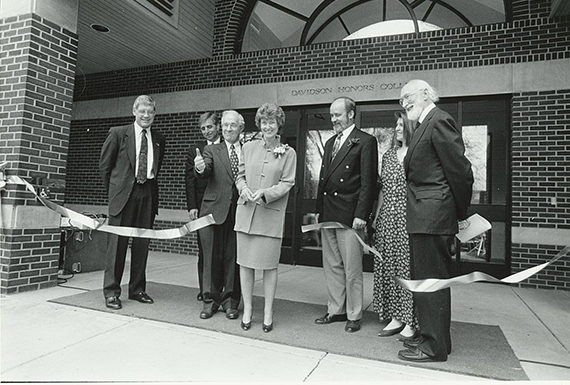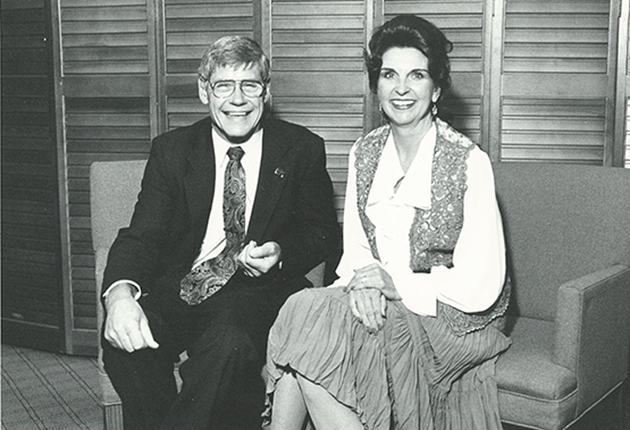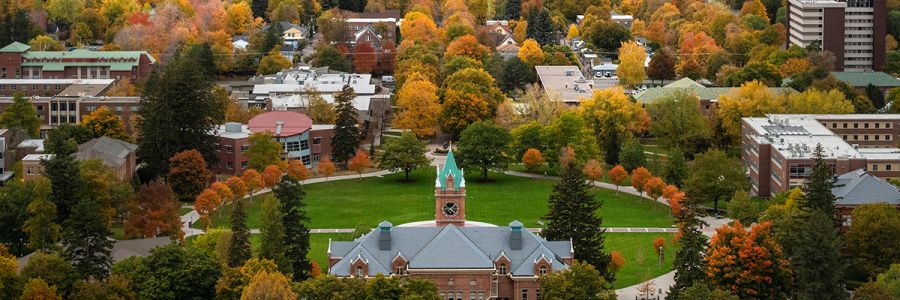Soaring Momentum, Surpassing Milestones: The 1990s Ushered in a Dynamic New Era of Giving at UM
Donors powered multiple major initiatives during a fast-paced decade on campus
August 13, 2025
This story is part of “75 Years of Impact,” a celebration marking the University of Montana Foundation’s 75th anniversary. Throughout the year the Foundation will share stories illustrating the profound impact of donors’ philanthropy at the University of Montana across the decades. To learn more visit SupportUM.org/UMF-75.
The 1990s were a vibrant and exciting time at the University of Montana.
In 1993, the University celebrated its centennial — a milestone that coincided with a decade of climbing enrollment and increasing national recognition for both academic and athletic achievement.
Fueled by a deep belief in UM’s mission to provide world-class, accessible education, research and public service, donors helped usher in an era of rapid growth and transformative impact across campus.
Supporters, alumni and friends of the UM Foundation launched a record-breaking fundraising campaign while simultaneously making unparalleled additional investments in student and faculty success as well as aiding landmark facilities upgrades.
It was a decade of big dreams driven by an energized and empowered giving community, which rallied to set new standards of excellence at the University.
A Vision Realized: The Davidson Honors College
The ceremonial groundbreaking for the first new building of UM’s second century took place on Oct. 29, 1993.
The Davidson Honors College, a 10,000-square-foot facility on the south side of the Oval, would provide a long-awaited permanent academic and social home for the University’s honors student community.
Prior to the new building’s construction, UM’s Honors College was housed on the third floor of Main Hall. However, by the early ’90s, its ranks had swelled well beyond that location’s capacity, growing from just 50 students in 1980 to more than 350 by 1993.
That’s when Ian and Nancy Davidson stepped in.
Graduates and lifelong champions of UM, the Davidsons believed deeply in the University’s educational vision. Their $1.1 million gift helped make the new building a reality, reaffirming and expanding UM’s commitment to offering enhanced academic opportunities and support.
In a news release at the time, then-UM President George Dennison called the new Honors College, “the intellectual heart of the University.”
"Our young people are Montana’s most valuable resource,” said Nancy Davidson, also in a release. “The Honors College will nurture and serve the brightest and most able of Montana’s college students.”
Completed in May 1996, the Davidson Honors College building provided much-needed space, accessibility upgrades and student-focused features like study rooms, a computer lab and a lounge. More than a building, it gave the Honors College a permanent identity and a dedicated space where honors students could thrive.

Today, the DHC continues to attract exceptional students from Montana and beyond, offering a dynamic community where academic rigor, mentorship and opportunity prepare students for leadership and lifelong learning. Thanks to generous donor support, many DHC students receive privately funded scholarships, including the Presidential Leadership Scholarships (PLS), the most prestigious awards for incoming students. In the 2025-26 academic year, 24 high-achieving students were selected for a PLS in recognition of their academic excellence and service to the community.

Kolter Stevenson, a Presidential Leadership Scholar from Amsterdam, Montana, recently became the 29th UM student to be awarded the Rhodes Scholarship, one of the oldest and most renowned academic fellowships in the world. Other recent prestigious awards earned by DHC students include the Udall Undergraduate Scholarship, the Barry Goldwater Scholarship and the Fulbright Scholarship.
Ensuring Excellence: UM’s Second Comprehensive Giving Campaign Breaks Records
On the same fall morning in 1993 that the first shovelfuls of dirt were turned for the new Honors College, the UM Foundation also announced the launch of its biggest fundraising campaign to date.
The “Ensuring a Tradition of Excellence” campaign sought to inspire $40 million in giving over the next four years to support a diverse set of crucial needs at the University, including endowments for faculty positions; expansion of scholarship support that would directly touch thousands of students; research opportunities; academic program enhancements; and building construction, renovation and equipment.
Donors embarked on the initiative just seven years after the successful completion of the Foundation’s first major campaign, which raised $7.8 million from 1984-86.
The new campaign would be even bigger, more comprehensive and more ambitious.
Like the ’80s campaign, it would be led by passionate, driven volunteers. Campaign Chair Phyllis Washington, a 1964 graduate of the University, captured the spirit of “Ensuring a Tradition of Excellence,” saying in a news release, “The quality of instruction I experienced at UM must be preserved and enhanced for students in the next 100 years and beyond.”

At the time of the public announcement of the campaign in fall 1993, donors had already contributed approximately $20 million toward the goal.
The campaign exceeded its original $40 million goal a year before its targeted completion date.
As the campaign closed the following October, the estate of Billings philanthropist Marty F. Arkwright contributed a $7.5 million gift to promote conservation and preservation of Montana’s wilderness and natural heritage.
This gift and many others helped push the campaign to a total tally of $71.4 million in giving, surpassing its original goal by more than $30 million.
A New Era for Business and Health Sciences
William and Rosemary Gallagher Building
By the 1990s, UM’s School of Business Administration (now called the College of Business) had long since outgrown its home at the center of campus northeast of Main Hall, where it had resided since 1950.
In 1990, University alum William Gallagher donated $1 million in seed money toward construction of a new building.
Gallagher’s donation galvanized public and private support for a project that topped the Montana Board of Regents’ long range building program. After the state Legislature approved partial funding in 1993, donors prioritized fulfilling the amount needed to complete the building, as well as purchasing new furnishings and equipment.
The result was the William and Rosemary Gallagher Building, completed in 1996. The modern facility centralized all School of Business Administration functions into one location and established a legacy of alumni-driven progress at the school.
Today, private support of the College of Business continues to reimagine and modernize the space, including features like the fully donor-funded Larry and DeeDee Gianchetta Student Success Center, which opened in 2016.
In the spring of 2025, donors also contributed to the opening of The DEN (Discover, Engage and Network), a 4,000-square-foot space that provides the next generation of student leaders a community-focused environment to connect, collaborate and prepare for their professional lives. The DEN includes individual and group workstations, updated study rooms and space to support hybrid work such as remote interviewing and networking.
Skaggs Building
Another major leap forward for UM’s facilities came in 1998, with a $10.4 million, 70,000-square-foot expansion of the Pharmacy and Psychology Building, thanks in part to a $5.7 million contribution from the ALSAM Foundation, established by L.S. “Sam” and Aline Skaggs.
The modernized building united the School of Pharmacy and Allied Health Sciences under one roof, offering updated labs, classrooms and a 250-seat lecture hall.
Today, the Skaggs Building houses UM’s College of Health and continues to provide vital space for education, research, clinics, collaboration and community outreach — carrying on the school's tradition of excellence in the health sciences.
The College of Health is home to research in public health, rehabilitation and health equity, including Montana’s rural and tribal communities, and offers hands-on learning through its on-campus clinics. Through robust student services, interdisciplinary training and a strong focus on workforce development, the college prepares students to meet the health care needs of both the state and region.
Partners in Progress: Corporate and Foundation Engagement Gains Ground
Throughout the 1980s and ’90s, gifts from corporations and foundations became more integral to the UM story.
By the mid-’90s, Foundation leadership recognized the need to deepen its relationships with regional and national foundations, corporations and philanthropic organizations that aligned with UM’s mission and goals. In February 1997, the Foundation hired its first Corporation and Foundation Relations (CFR) officer.
From securing support for professorships and faculty research and funding capital projects to advancing student programs and community initiatives, the CFR department quickly became a vital conduit for advancing the University’s core purpose and priorities. Its creation reflected UM’s ever-increasing reach — as well as the University’s evolving ability to connect with mission-driven partners ready to make meaningful contributions to education, research and the public good.
Today, the CFR department continues this legacy, engaging entities to meet their philanthropic goals while supporting the University’s mission. In 2025, private grant-makers contributed more than $15 million directly to UM in support of research and scholarship.
A Pivotal Time at UM
The 1990s were a decade defined not only by extraordinary success but also by a shared belief in the University’s ability to change the lives of students from around the globe. Private giving was solidified as a foundational element of providing opportunities and advancement to an expanding and diversifying campus community.
The remarkable generosity and vision of donors from this era fueled unprecedented growth — and the results continue to resonate today.
Improvements made during the decade further built on the University's hundred-year-long tradition of innovation, accessibility and opportunity, truly setting the tone for the institution’s next century.
To learn more about the Foundation’s 75th anniversary and read feature stories spanning the decades, please visit SupportUM.org/UMF-75.
The information on this website was compiled from a variety of sources, including records held by the UM Foundation and the Maureen and Mike Mansfield Library Archives and Special Collections. The UM Foundation has made its best efforts to provide an accurate representation of events, people, entities, names, activities and data. However, the information presented should not be considered a definitive historical record.
